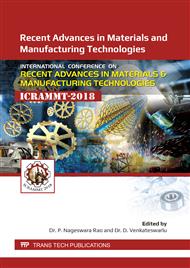p.303
p.309
p.315
p.321
p.327
p.335
p.343
p.349
p.355
Shear Strength of BC-Soil Admixed with Lime and Bio-Enzyme
Abstract:
This BC Soil are expansive in nature and are problematic because of low shear strength and high compressibility. Review of literatures have proven that addition of lime imparts high strength with a corresponding reduction in swell of BC soils. In addition, Bio-enzymes have also been found to play a key role as activators in improving the characteristics of clayey soils such as BC soil. Development and use of non-traditional ground improvement techniques such as bio-enzymes in combination with lime for soil stabilization helps to reduce the cost and the detrimental effects on the soil environment. In the present study lime and bio-enzymes were used as soil stabilizing agents. Compaction test results on BC soil admixed with different percent of lime indicated that 3% addition lime gives higher maximum dry density of 17kN/m3 with OMC of 21% compare to other addition of lime percentages. Keeping 3% of lime as optimum lime content(OLC), BC Soil was admixed with different dosages of Bio-enzymes 25ml/m3, 50ml/m3, 100 ml/m3,150ml/m3, and 200ml/m3 along with OLC was tested for compaction and unconfined compressive strength(UCC). Further UCC test was carried out for different curing period of 0, 7, 15, 30, and 60 Days to analyse the long term effect of BC soil admixed with bio-enzymes with and without lime content. Morphological and chemical analysis was done by using XRD and SEM analysis, from all the test results it was found that 3%OLC + 75ml/m3 of bio-enzymes for 7 day of curing gives higher UCC of 450 kPa. From the SEM it was found that better bond between particles found to develop in bio-enzyme+ lime admixed BC soil in comparison with lime alone admixed BC soil. XRD studies indicated morphological changes in crystallinity and structure of stabilized BC soil in comparison to BC soil alone.
Info:
Periodical:
Pages:
327-334
Citation:
Online since:
August 2019
Authors:
Price:
Сopyright:
© 2019 Trans Tech Publications Ltd. All Rights Reserved
Share:
Citation:


